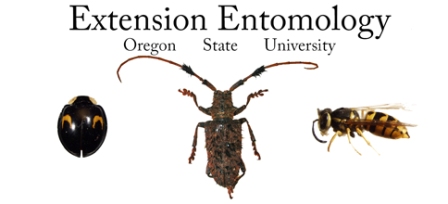| Oregon
State University Insect ID Clinic |
|||||||||||
 |
|||||||||||
|
Common SubmissionsAntheraea polyphemus "Polyphemus Moth"
Large silk moth that is seen in Oregon from mid-July to August. The wing span can be an amazing 4-6 inches. Prionus sp. "Prionus Beetles"
Large beetles that can be as large or larger than your thumb. As grubs these beetles feed on the roots of trees and shrubs. For more information on these beetles click here . Monochamus sp. "Sawyer Beetles"
These native beetles are commonly mistaken for the Asian Longhorn Beetle (ALB). If you see one of these beetles and you are not sure if it is one of our native species or the ALB please submit it to the clinic for identification. Buprestis aurulenta "The Golden Buprestid"
This showy wood boring insect is commonly found in flowers feeding on pollen. The beetle as an immature feeds under the bark of Ponderosa Pine and Douglas Fir. For more information visit the University of British Columbia Forest Pests Page . Noctua pronuba "Large Yellow Underwing"
Although it is called the "Yellow Underwing" the underwings of this moth are typically a bright orange. The caterpillar of this moth is commonly known as a cutworm and is a common pest of tomato, potato, carrot, strawberry, grape, onions, spinach, mustard and grass. Plodia interpunctella "Indian Meal Moth"
Anthrenus verbasci "Variegated Carpet Beetle"
This is a common household pest that can feed on virtually anything including glue, paper, carpet fibers, stored grains, pet food, and pollen. The image on the right is the larva, pupa and the empty larval skin. For more information on this pest and other dermestid beetles visit http://ohioline.osu.edu/hyg-fact/2000/2103.html Paracotalpa granicollis "Little Bears"
This species is commonly encountered in spring feeding on apple blossoms and the leaves of peach trees. Unfortunately the feeding habits of the larva is unknown, however some suggest that it may feed on the roots of native grasses. Altica ambiens "Alder flea Beetle"
This pest feeds on the leaves of alder both as an adult and as an immature. The larvae skeletonize the leaves (eating the leaf tissue but leaving all of the veins, resulting in a lace-like appearance) while the adults are shot-hole feeders (eating out small to medium sized circles of leaf material). The adults overwinter at the base of the tree and emerge in the spring to feed and lay eggs. The larvae are present from late spring into late summer. Centrodera spurca "Douglas Fir Borer" This is a common long horned beetle in the west that feeds under the bark of Douglas-fir as a larva. The black spots on the sides of the beetle distinguish it from some of the other species that occur in Oregon . Rosalia funebris "Banded Alder Borer" This is a longhorn beetle that is commonly found throughout the west. The larvae feed in the trunks of dead of maple, alder, ash, sycamore, oak and willow. The adults emerge in mid-summer and are often found by home owners. Note that the light colored areas of this beetle can vary from bright white to a pale blue. More information is available at: http://www.puyallup.wsu.edu/plantclinic/resources/pdf/pls55bandedalder.pdf Lygus hesperus "Western Lygus Bug"
This is a common pest that is encountered during the summer. It feeds on a very wide array of plants including several of agricultural importance. The cream colored heart on the back of the insect is a good (but not absolute) identifier of this species. Calligrapha multipunctata bigsbyana "Leaf beetle"
This beetle is a common pest that feeds on willow leaves as an adult and larva. This pest is common in the urban garden where it feeds on ornamental willows. Gluphisia severa "Banded Pebble"
This moth is one of the first to emerge in spring and can be commonly found at lights starting in May. As a caterpillar it feeds on birch, cherry, willow and aspen, however it rarely causes enough damage to be noticed. Phyllodesma americana "The American Lappet Moth"
This moth commonly feeds on oak, poplar, aspen, and willows. The caterpillar of this species is a solitary feeder that rarely causes enough damage to draw attention. Ctenicera lobata "Click Beetle"
This is a pest of economic importance in British Columbia on cereal crops, grains, vegetables and grasses.
|
|||||||||||
June 11, 2013
Disclaimer